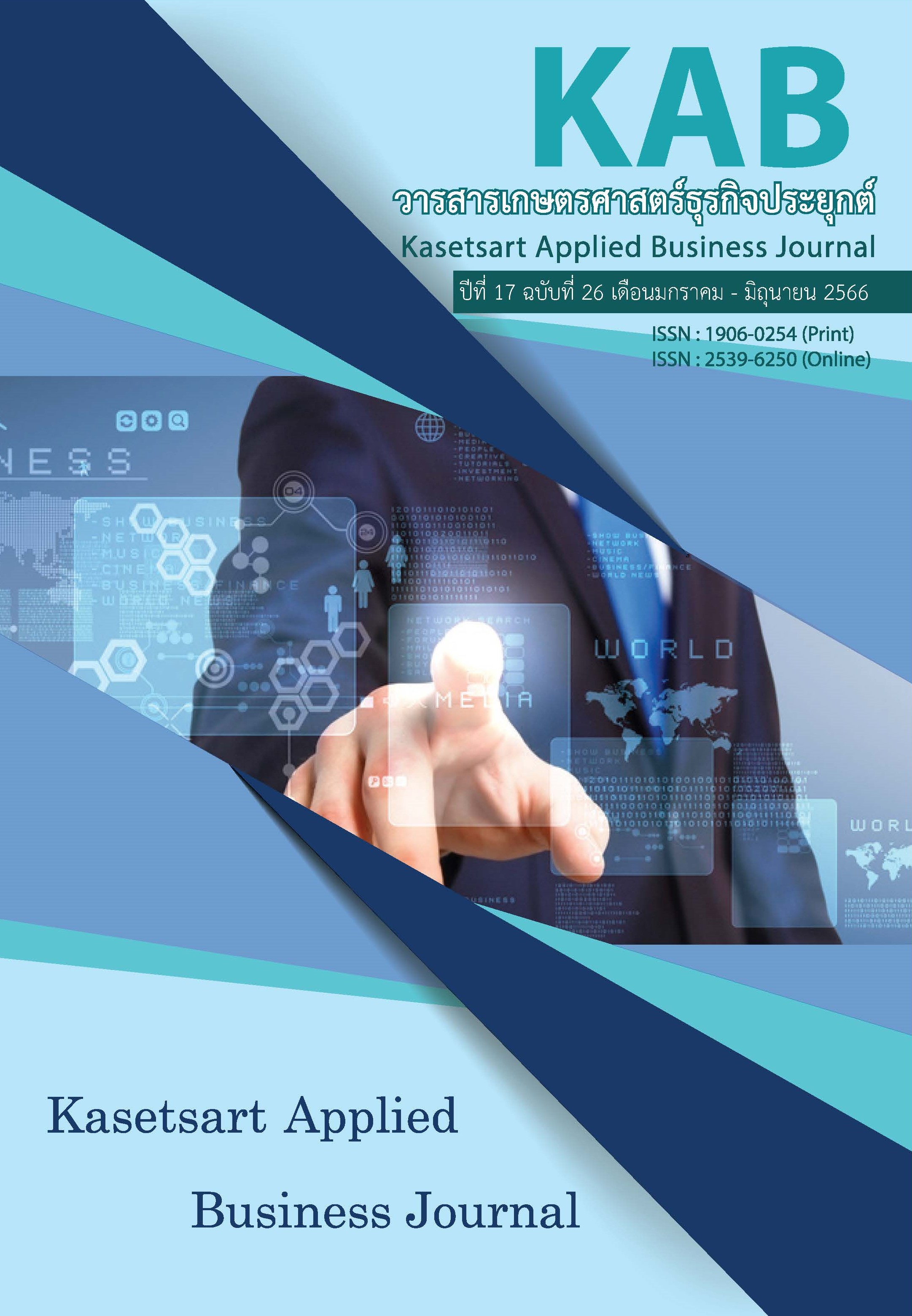เพิ่มความสนุก ประโยชน์ และลดความเสี่ยง สามารถยกระดับความตั้งใจในการยอมรับการซื้อสินค้าออนไลน์ของผู้สูงอายุในยุคโควิค 19
Main Article Content
บทคัดย่อ
การเกิดขึ้นของระบบอินเทอร์เน็ตได้สร้างโอกาสและความท้าท้ายให้กับหลาย ๆ ธุรกิจโดยเฉพาะอย่างยิ่งธุรกิจที่มีการซื้อขายสินค้าและบริการผ่านเครือข่ายอินเทอร์เน็ตในยุคโควิค 19 ในขณะที่ประเทศไทยก็จะก้าวไปสู่สังคมผู้สูงอายุโดยสมบูรณ์อีกไม่กี่ปีข้างหน้า เพื่อเป็นข้อมูลแก่ผู้ประกอบการสามารถวางแผนและดำเนินกลยุทธ์ให้สอดคล้องกับผู้บริโภคในกลุ่มผู้สูงอายุ ดังนั้นการศึกษานี้มีวัตถุประสงค์ เพื่อศึกษาระดับความตั้งใจในการยอมรับการซื้อสินค้าออนไลน์ของผู้สูงอายุ พร้อมด้วยศึกษาปัจจัยที่มีผลต่อความตั้งใจในการยอมรับการซื้อสินค้าออนไลน์ของผู้สูงอายุ ประกอบด้วย 5 ปัจจัยได้แก่ การรับรู้ถึงประโยชน์ที่เกิดจากการใช้ ความง่ายในการใช้งาน ความสนุก ความเชื่อใจในผู้ขายและความเสี่ยง
ประชากรในการศึกษาคือผู้ที่มีอายุตั้งแต่ 60 ปีขึ้นไป ในพื้นที่สามจังหวัดชายแดนภาคใต้ แบบสอบถามที่สอดคล้องกับวัตถุประสงค์ถูกสร้างขึ้นมาเพื่อเป็นเครื่องมือในการวิจัย โดยเก็บกลุ่มตัวอย่างจำนวน 450 ราย วิเคราะห์ข้อมูลใช้โปรแกรมสำเร็จรูป SPSS และ Smart PLS ผลการศึกษาระดับความตั้งใจในการยอมรับการซื้อสินค้าออนไลน์ของผู้สูงอายุรายงานว่าผู้สูงอายุมีความตั้งใจในการซื้อสินค้าออนไลน์ในระดับปานกลาง สำหรับผลการศึกษาปัจจัยที่มีอิทธิพลต่อความตั้งใจในการยอมรับการซื้อสินค้าออนไลน์ของผู้สูงอายุ พบว่าความสนุกมีอิทธิพลทางตรงต่อความตั้งใจในการยอมรับการซื้อสินค้าออนไลน์ของผู้สูงอายุมากที่สุด ตามด้วยความเสี่ยงและการรับรู้ถึงประโยชน์ที่เกิดจากการใช้ตามลำดับ ในขณะที่การรับรู้ถึงความง่ายในการใช้งานและความเชื่อใจในผู้ขาย ผลการวิเคราะห์รายงานว่าไม่มีอิทธิพลอย่างมีนัยสำคัญทางสถิติต่อความตั้งใจในการยอมรับการซื้อสินค้าออนไลน์ของผู้สูงอายุ
Article Details

อนุญาตภายใต้เงื่อนไข Creative Commons Attribution-NonCommercial-NoDerivatives 4.0 International License.
Journal of TCI is licensed under a Creative Commons Attribution-NonCommercial-NoDerivatives 4.0 International (CC BY-NC-ND 4.0) licence, unless otherwise stated. Please read our Policies page for more information...
เอกสารอ้างอิง
กรมการปกครอง. (2561, 5 ธันวาคม). สถิติผู้สูงอายุของประเทศไทย 77 จังหวัด ณ.วันที่ 31 ธันวาคม 2560. http://www.dop.go.th/download/knowledge/th1533055363-125_1.pdf
คณะพยาบาลศาสตร์ มหาวิทยาลัยมหิดล. (2564, 13 กรกฎาคม). ความเสี่ยง และผลกระทบต่อผู้สูงอายุในช่วง Covid-19. https://www.dmh.go.th/news-dmh/view.asp?id=30794
มูลนิธิสถาบันวิจัยและพัฒนาผู้สูงอายุไทย. (2562). สถานการณ์ผู้สูงอายุไทย พ.ศ. 2561. บริษัท พริ้นเทอรี่.
สำนักงานพัฒนาธุรกรรมทางอิเล็กทรอนิกส์. (2563, 10 ธันวาคม). การสำรวจพฤติกรรมผู้ใช้อินเทอร์เน็ตในปี 2563. https://www.etda.or.th/th/newsevents/pr-news/ETDA-released-IUB-2020.aspx
สำนักงานพัฒนาธุรกรรมทางอิเล็กทรอนิกส์. (2564, 22 กรกฎาคม). สรุปเรื่องการร้องเรียนออนไลน์. https://www.etda.or.th/th/newsevents/pr/1212-OCC-Statistic-2020.aspx
Ajzen, I. (1991). “Theory of planned behavior”. Organization Behavior and Human Decision Process, 50, 179‐211.
Armstrong, G., & Kotler, P. (Eds.). (2013). Marketing an introduction (11 ed.). England: Pearson Education.
Ashfaq, M., Yun, J., Waheed, A., Khan, M. S., & Farrukh, M. (2019). Customers’ expectation, satisfaction, and repurchase intention of used products online: Empirical evidence from China. SAGE Open, 9(2). https://doi.org/10.1177/2158244019846212
Bianchi, C., & Andrews, L. (2012). Risk, trust, and consumer online purchasing behavior: a Chilean perspective. International Marketing Review, 29(3), 253-275.
Chen, H., Rong, W., Ma, X., Qu, Y., & Xiong, Z. (2017). An extended technology acceptance model for mobile social gaming service popularity analysis. Mobile Information Systems, 2017.
Corbitt, B. J., Thanasankit, T., & Yi, H. (2003). Trust and e-commerce: a study of consumer perceptions. Electronic commerce research and applications, 2(3), 203-215.
Davis, F. D. (1989). Perceived usefulness, perceived ease of use, and user acceptance of information technology. MIS quarterly, 13(3), 319-340.
Fastoso, F., Whitelock, J., Bianchi, C., & Andrews, L. (2012). Risk, trust, and consumer online purchasing behaviour: a Chilean perspective. International Marketing Review, 29(3), 253-275.
Fishbein, M., & Ajzen, I. (1975). Belief, attitude, intention and behavior: An introduction to theory and research. Boston, MA: Addison-Wesley.
Gefen, D., Karahanna, E., & Straub, D. W. (2003). Trust and TAM in online shopping: An integrated model. MIS Quarterly, 27(1), 51-90.
Hair, J. F., Hult, G. T. M., Ringle, C. M., & Sarstedt, M. (2013). A Primer on Partial Least Squares Structural Equation Modeling (PLS-SEM). Sage, Thousand Oaks.
Hassanein, K., & Head, M. (2007). Manipulating perceived social presence through the web interface and its impact on attitude towards online shopping. International Journal of Human-Computer Studies, 65(8), 689-708.
Krejcie, R. V., & Morgan, D. W. (1970). Determining sample size for research activities. Educational and psychological measurement, 30(3), 607-610.
Lee, M. C. (2009). Predicting and explaining the adoption of online trading: An empirical study in Taiwan. Decision Support Systems, 47(2), 133-142.
Macik, R., & Macik, D. (2016). Trust and product/sellers reviews as factors influencing online product comparison sites usage by young consumers. Managing Global Transitions, 14(2), 195-215.
Miller, R. L. (2015). Rogers' innovation diffusion theory (1962, 1995). In Information seeking behavior and technology adoption: Theories and trends (pp. 261-274). IGI Global.
Nabot, A., Garaj, V., & Balachandran, W. (2018). Consumer attitudes toward online shopping: an exploratory study from Jordan. In Mobile Commerce: Concepts, Methodologies, Tools, and Applications (pp. 1110-1123). IGI Global.
Nielsen. (2016).The new age of Thais. https://www.nielsen.com/th/th/press-room/2016/new-age-of-thais.html
Positioning. (2016). “ผู้สูงวัย” เทรนด์ลูกค้ามาแรง ! แต่ทำไมนักการตลาดยังมองข้าม. https://positioningmag.com/1100674
Rani, T. S., & Sripathi, N. (2017). Online shopping purchase patterns with special reference to demographic and informational influence. International Journal of Social Sciences and Management, 4(1), 38-43.
Rasool, A., Gupta, V., Slathia, B., & Mahajan, G. (2017). Online shopping adoption and influencing factors: A study in Karnataka. Apeejay-Journal of Management Sciences and Technology, 42, 29-40.
Statista. (2021). Leading countries based on retail e-commerce sales growth in 2020. https://www.statista.com/statistics/266064/revenue-growth-in-e-commerce-for-selected-countries
Swinyard, W. R., & Smith, S. M. (2003). Why people (don't) shop online: A lifestyle study of the internet consumer. Psychology & Marketing, 20(7), 567-597.
Venkatesh, V. (2000). Determinants of perceived ease of use: integrating control, intrinsic motivation, and emotion into the technology acceptance model. Information Systems Research, 11(4), 342–365.
Zikmund, W. G., Carr, J. C., & Griffin, M. (2013). Business Research Methods. Cengage Learning.


